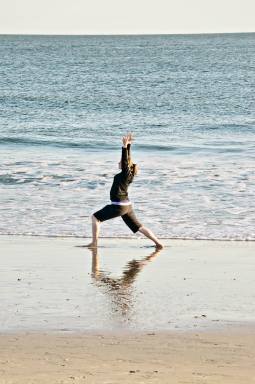 I found Cope’s approach to this book pretty fascinating. He began writing the book with the intention of writing a traditional commentary on Patanjali’s Yoga Sutras, and he completed exhaustive research into yoga philosophy and Sanskrit with this in mind; however, the focus of the project morphed and shifted as he wrote. The final book includes three intertwining components: commentary and explanation of the yoga sutras, explication of the sutras from a modern psychological perspective based on Cope’s experience as a psychotherapist, and a semi-fictionalized/loosely memoirish account of the yoga explorations of Cope and five of his friends during the years Cope was working on the book.
I found Cope’s approach to this book pretty fascinating. He began writing the book with the intention of writing a traditional commentary on Patanjali’s Yoga Sutras, and he completed exhaustive research into yoga philosophy and Sanskrit with this in mind; however, the focus of the project morphed and shifted as he wrote. The final book includes three intertwining components: commentary and explanation of the yoga sutras, explication of the sutras from a modern psychological perspective based on Cope’s experience as a psychotherapist, and a semi-fictionalized/loosely memoirish account of the yoga explorations of Cope and five of his friends during the years Cope was working on the book.
The book benefits immensely from Cope’s philosophical and spiritual research without becoming too esoteric for the beginner. Cope discusses key concepts from Patanjali, such as the steps of the eightfold path, in an accessible way; he also relates some of Patanjali’s teachings on meditation and the mind to similar teachings in Buddhism, which I was really intrigued by and hadn’t seen elsewhere.
Cope’s perspective as a psychotherapist helps to elucidate for the modern reader why this yoga stuff actually works and what it does to our minds. I personally found the psychological verbiage to be a little heavy and technical for my taste, so I didn’t spend a lot of time dissecting and digesting it, but I still found those passages to be interesting and informative even at a casual reading pace and level.
What really kept me moving through the text were the stories of Cope and his friends. Cope would describe one person’s particular struggle – overeating, a lying habit, a lifelong conflict with a family member – then use that almost as a case study to discuss what, yogically and psychologically, was going on for that person, and show how yoga and meditation could help. Cope includes conversations among the friends as well, as they help one another work through their various issues. Each character makes progress on a spiritual path throughout the book, each in his or her own way, including the character of Cope himself as he struggles with the book he’s writing.
Wanting to know what happened next for the characters kept me moving through the spiritual and philosophical material, some of which was very familiar to me, and the more technical psychological stuff, so I found the framework to be a useful and interesting way of organizing the book. Overall I really enjoyed the book’s unique approach and would recommend it, particularly to those who want to explore the ancient philosophy of yoga and the mind from a modern perspective.





